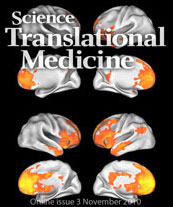
一项新的研究提示,在自闭症患者中常常看到的语言和认知困难可能有部分是由脑额叶中的过度连接造成的,该研究指出,一个叫做CNTNAP2的基因与脑前部神经元之间的连接有关。
如果携带不同版本的CNTNAP2基因总被发现是语言困难的一个预测因子的话,那么该发现可能会帮助研究人员设计特定的治疗计划,以协助脑子在早期就朝着一个较为正常的发育道路方向发展。 研究人员甚至有可能可以通过检测病人在治疗前后的神经元的联通性,来检查并观察特异性的治疗是否真的改变了脑功能。 重要的是要注意到,在本研究中所发现的额叶联通性的模式是正常基因变异谱的一部分。 因此,仅仅携带该风险基因并不足以被诊断患有自闭症或智力丧失。 自闭症和其它复杂的神经发育性疾病可能是由许多基因的组合所引起的,所以,尽管这一特别的危险版本的CNTNAP2基因会指示脑子形成更多的额叶联系,但要引起整个的病症需要有许多其他基因的参与。
Ashley Scott-Van Zealand及其同事通过对一组儿童的脑部进行扫描而查明了因2种变异体的CNTNAP2基因所引起的脑中联通性和功能上的差别,其中一种变异体会带来自闭症的风险。 CNTNAP2是在发育时在脑的额叶和颞叶中正常表达的基因,额叶和颞叶是人们已知的参与语言和学习的区域。 对携带风险基因的儿童的脑扫描披露了一个脱节的脑子,这意味着这些脑子中的额叶与脑子的其它部位没有发生恰当的连接,并在额叶之中有着过度的连接。 结果,额叶“自我交谈”的程度多于和脑部其它区域之间的交谈,并且额叶缺乏其与脑后部的较长距离的连接。 该研究团队发现,这一额叶脑联通性增加的模式与CNTNAP2基因的DNA序列差异有联系。 另外一个与这一基因有关的有趣发现是其在左脑和右脑之间的联通性上的差异,这种差异取决于试验参与者所携带的CNTNAP2基因版本。 左侧脑常常与说话和理解等语言功能有关。 在携带非风险版本CNTNAP2基因的孩子中,Scott-Van Zealand及其同事发现,额叶脑区会优先与左侧脑子连接;而在那些携带有风险版本CNTNAP2基因的孩子中,额叶与右侧和左侧脑子都有连接。
推荐英文摘要:
Sci Transl Med 3 November 2010:
Vol. 2, Issue 56, p. 56ra80
DOI: 10.1126/scitranslmed.3001344
Altered Functional Connectivity in Frontal Lobe Circuits Is Associated with Variation in the Autism Risk Gene CNTNAP2
Ashley A. Scott-Van Zeeland1,2,3, Brett S. Abrahams4,*, Ana I. Alvarez-Retuerto4,5, Lisa I. Sonnenblick4, Jeffrey D. Rudie2, Dara Ghahremani6, Jeanette A. Mumford7, Russell A. Poldrack7, Mirella Dapretto5,6,8, Daniel H. Geschwind4,5,?? and Susan Y. Bookheimer1,5,6,7,??
1Center for Cognitive Neuroscience, Semel Institute for Neuroscience and Human Behavior, David Geffen School of Medicine, University of California, Los Angeles, CA 90095, USA.
2Neuroscience Interdepartmental Program, David Geffen School of Medicine, University of California, Los Angeles, CA 90095, USA.
3Scripps Translational Science Institute, La Jolla, CA 92037, USA.
4Program in Neurogenetics, Department of Neurology, David Geffen School of Medicine, University of California, Los Angeles, CA 90095, USA.
5Center for Autism Research and Treatment, Semel Institute for Neuroscience and Human Behavior, David Geffen School of Medicine, University of California, Los Angeles, CA 90095, USA.
6Department of Psychiatry and Biobehavioral Sciences, David Geffen School of Medicine, University of California, Los Angeles, CA 90095, USA.
7Department of Psychology, David Geffen School of Medicine, University of California, Los Angeles, CA 90095, USA.
8Ahmanson-Lovelace Brain Mapping Center, David Geffen School of Medicine, University of California, Los Angeles, CA 90095, USA.
Genetic studies are rapidly identifying variants that shape risk for disorders of human cognition, but the question of how such variants predispose to neuropsychiatric disease remains. Noninvasive human brain imaging allows assessment of the brain in vivo, and the combination of genetics and imaging phenotypes remains one of the only ways to explore functional genotype-phenotype associations in human brain. Common variants in contactin-associated protein-like 2 (CNTNAP2), a neurexin superfamily member, have been associated with several allied neurodevelopmental disorders, including autism and specific language impairment, and CNTNAP2 is highly expressed in frontal lobe circuits in the developing human brain. Using functional neuroimaging, we have demonstrated a relationship between frontal lobar connectivity and common genetic variants in CNTNAP2. These data provide a mechanistic link between specific genetic risk for neurodevelopmental disorders and empirical data implicating dysfunction of long-range connections within the frontal lobe in autism. The convergence between genetic findings and cognitive-behavioral models of autism provides evidence that genetic variation at CNTNAP2 predisposes to diseases such as autism in part through modulation of frontal lobe connectivity.







